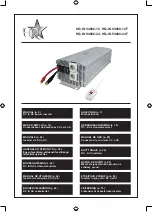
6R
Select Battery Charger-Limiting Points—OPTIONAL
“Most Limiting”
(#B2 & #B1 Up):
Charger-limiting takes effect the moment
any 120V AC load is applied; charger
output falls gradually from full output at
no 120V load passing through to no output
at full load.
“Less Limiting”
(#B2 Up & #B1 Down):
Charger-limiting begins when the
Inverter/Charger’s load reaches 33% of the
Inverter/Charger’s load rating. Charger
output falls gradually from full output at
33% of the Inverter/Charger’s load rating to about 40% of full output
at full load.
Configuration
(continued)
B1
B2
B3
B4
B1
B2
B3
B4
Group B DIP Switches
Select AC Sharing—OPTIONAL
Your Inverter/Charger features a high-output battery charger that can draw a significant amount of AC power from your utility source or
generator when charging at its maximum rate. If your unit is supplying its full AC power rating to its connected heavy electrical loads at the
same time as this high charging occurs, the AC input circuit breaker could trip, resulting in the complete shut off of pass-through utility power.
To reduce the chance of tripping this breaker, all MRV Inverter/Chargers may be set to automatically limit the charger output. This keeps the sum
of the unit’s AC load and charge power within the circuit breaker rating. This charger-limiting function has four settings, allowing you to
reduce the charger’s draw lower and lower, as needed, if the AC input circuit breaker keeps tripping under the normal AC loads of devices
you have connected downline from the unit. The figures show how to set your DIP Switches for charger-limiting.
B1
B2
Set Battery Charging Amps—OPTIONAL
Check specifications for your unit’s high- and
low-charging amp options. By setting on
high charging, your batteries will charge at
maximum speed and your RV 12V DC
system loads will be well-supplied. When
setting on low charging, you lengthen the life of your batteries
(especially smaller ones).
Battery Charger
Switch Position
Low Charge Amps
Up
High Charge Amps
Down (factory setting)
CAUTION: When switching to the High Charge Amp setting, the user must ensure that the
amp hour capacity of their battery system exceeds the amperage of the High Charge Amp
setting or the batteries may be damaged or degraded.
Select Equalize Battery Charge—OPTIONAL
This DIP Switch is momentarily engaged
to begin the process of equalizing the
charge state of your battery’s cells by time-
limited overcharge of all cells. This can
extend the useful life of certain types of
batteries; consult with your battery’s manufacturer to determine if
your batteries could benefit from this process. The charge
equalization process is automatic; once started, it can only be
stopped by removing the input power.
Setting Procedure
• Move to “Equalize” (DOWN) position for three seconds.
• Move to “Reset” (UP) position and leave it there. This is the
factory default setting.
CAUTION: Do not leave DIP switch #B3 in the down position after beginning process. Battery
charge equalization should only be performed in strict accordance with the battery manufacturer’s
instructions and specifications.
Battery Charge
Switch Position
Reset
Up (factory setting)
Equalize
Down—momentarily
B1
B2
B3
B4
Reset
Equalize
B1
B2
B3
B4
B4
B3
(factory setting)































